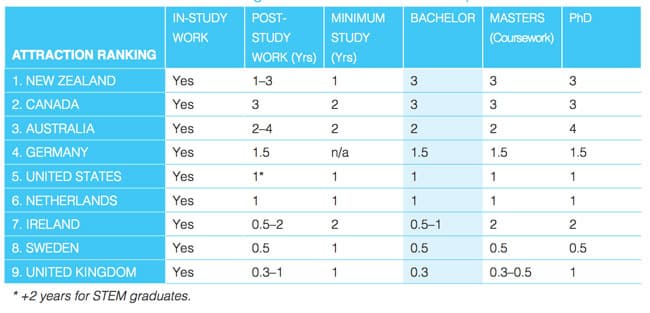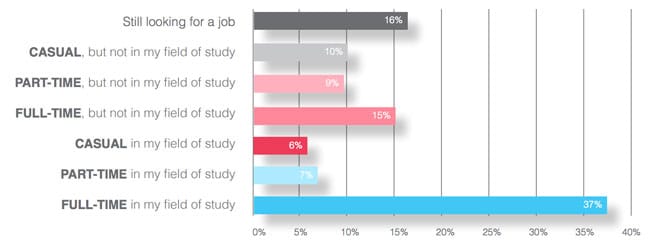Study compares post-study employment offers and outcomes for international students
A newly released paper highlights the increasing weight that international students and educators are placing on students’ employment outcomes, but also the challenges that visiting students face in securing employment in their field of study after graduation.
Commissioned by the International Education Association of Australia (IEAA), Global perspectives on international student employability provides some important background on post-study work policies in major study destinations around the world.
The paper makes the point that many international study destinations have experienced a “general de-funding of public education” and have turned to international student markets in part to recover additional revenues to make up for this shortfall. While not specifically cited in the report, the prevailing demographic trends in many destination countries – particularly a decline in college-aged populations – along with a drive to internationalise campuses and boost the global competency of graduating students have also been important drivers for many institutions in expanding their international enrolments.
Keying on the funding challenges facing higher education institutions in the major English-speaking study destinations, the paper observes, “It is no surprise then that these markets, which also charge the highest differential tuition fees for international students, have sought to position their brands around employability through policies that allow international students to work during their studies and to stay in the host country and work for a fixed period after graduation. These same countries also recognise the value of retaining the highly qualified graduates in their labour market and periodically revise their immigration policy settings to align with changing market conditions.”
The following table summarises the current work rights policy settings in the study destinations examined in the report.

The gap between intention and experience
The report highlights significant gaps between student intentions with respect to post-study work, and the students’ actual employment outcomes after graduation. The authors note that student surveys routinely indicate that 60–80% of foreign students intend to stay and work in their study destination after completing their studies, but that the long-term stay rate across OECD countries is closer to one in four.
There are a number of reasons behind this discrepancy but the authors cite four in particular: “For international students wishing to pursue post-study work or long-term employment in their host country of study, multiple studies in different markets have identified common barriers of foreign language challenges, lack of exposure to the work environment of the host market, insufficient professional networks, and employer misperceptions or lack of awareness of work policies.”
The clear implication in all this is the need for additional career supports for foreign students. The report observes generally that the career transition services available have not kept pace with growing demand from increasing international student populations. It notes as well, however, that many institutions are working to strengthen those supports through new technology tools and new partnerships with employers and other stakeholders.
“Traditionally seen as a potential market advantage by individual providers, employability support is emerging as a multi-stakeholder approach requiring partnership with local, regional and national governments and across competing institutions,” the authors add. “Providing adequate support towards graduate employability is vital to sustaining the long-term enrolment targets set by governments and individual institutions.”
The Australian example
The paper concludes with a series of case studies on graduate work outcomes in selected study destinations. Australia figures prominently in this analysis, with a particular focus on the Australian Temporary Graduate Visa (also known as the “485 visa”).
There are two streams in this visa class. The Graduate Work stream is for foreign students who have graduated with skills and qualifications that correspond to identified labour market requirements in Australia. These visas are typically granted for 18-month periods of work in designated occupations.
The second stream, the Post-Study Work stream, provides for extended work periods for those graduating with higher education qualifications. Visas in this stream are granted for two, three, or four years, depending on the level of degree obtained. “The dominant 485 visa stream is the Post-Study Work stream,” says the IEAA paper, “comprising 84.2% of 485 visa grants in 2017/18, up from 37.5% in 2014/15. Within this stream, the number of visas issued has risen from just over 1,000 in 2013/14 to over 40,000 in 2017/18.”
An analysis by researcher Dr Ly Thi Tran found that, “The challenges international graduates face in their attempts to get access to the Australian labour market while on the post-study work visa help them to realise the importance of English language proficiency, work experience, internships and social and professional networks in enabling them to secure employment. Therefore, many of them strategically use the ‘more time’ in the host country afforded through the post-study work visa to invest their resources in enhancing their English language proficiency, gaining work experience and expanding their networks.”
In a related finding, Dr Tran points out that permanent residency and temporary post-study work goals are linked for many students, and not because the idea of staying to work after graduation is seen as a pathway to migration. “The post-study work visa is not perceived to provide international graduates with a competitive advantage on the Australian labour market… the Australian employers with whom [the graduating students] engaged either prefer the [permanent residency] visa to the temporary graduate visa or are unclear what the latter entails. For example, one respondent mentioned ‘most firms don’t hire people on a temporary visa.’”
In other words, many students feel they need to secure permanent residency in order to improve their chances at obtaining full-time employment in their field of study.
Those findings are reinforced by the results of a related survey conducted by Dr Tran. Among 801 onshore survey respondents – that is, those remaining in Australia after graduation – 37% reported that they were in full-time employment in their field. Another 15% were also employed full-time (but outside of their field of study), while 16% were still seeking employment.

Six in ten respondents said that the 485 visa was helpful in providing a path to permanent residency. Seven in ten said that they felt the visa helped them to obtain some work experience in Australia. But many students also clearly reported that the temporary 485 visa was not a competitive advantage in their job search, whether because employers were unfamiliar with that visa status, or because the visa term was too short to be of interest to employers, or because the graduates lacked the language proficiency or professional networks to obtain full-time employment during the 485 visa window.
“To some extent,” Dr Tran concludes, “this result is consistent with the findings of the in-depth interviews and open-ended questions from the survey where international graduates articulated how the visa provides them with ‘more time’ to gain some work experience and improve their English, and acts as a stepping stone to permanent residency. However, it does not give them a ‘competitive advantage’ in terms of securing a full-time employment, especially in their field of study.”
For additional background, please see:















